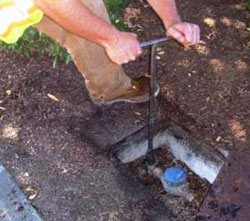
It might be cost effective to have a new pipe installed with trenchless boring techniques. It could be made of lead pipe, it could have corrosion built up inside it, who knows. (bear with me here) maybe it's time for an upgrade/replacement of the service line. You may be able to negotiate with the city for a half-hour shut down of the section your house is connected to.įinally. They're frequently found at intersections. The city will have shutoff valves in their mains. In any case, merely having the line marked doesn't tell you where along the line the valve might be buried. Private underground locators also exist but I can't speak to their cost. At that age your service line is almost certainly metallic so a locator worth their salt should be able to connect a transmitter to the line and locate it. so if the city water department already can't find your pipe, 811 may be no help. Unfortunately the markings would be made by the utility owner (or their contractor). The one-call 811 service won't mark private facilities but they should mark at least the city-owned pipe coming from the street. Freeze the pipe, but instead of proceeding with the valve replacement, open a faucet and wait to see how much working time the freeze provided. There are plenty of risks involved, mostly distilling to "what happens if we get the old valve off but water gushes through before the new valve is in place?" I can't give advice on that, but I could suggest that you test the technique first. Procedure could vary depending on whether the new valve can thread on to an existing adapter or pipe end or whether it's necessary to solder something (in the case of a copper tube service line).

Have sufficient quantity of dry ice on hand to maintain the frozen section for longer than it takes to bring more dry ice, just in case things go horribly wrong and you need to maintain it frozen longer than expected. It's probably a good idea to freeze a section several inches long at minimum. I suppose it might go something like the following.Ĭhoose a location on the pipe sufficiently far from the valve to be replaced and pack dry ice around the pipe. Take this as an entirely untested theory. I've heard tales of stopping a pipe for valve replacement by freezing the water but I haven't ever attempted it.


 0 kommentar(er)
0 kommentar(er)
